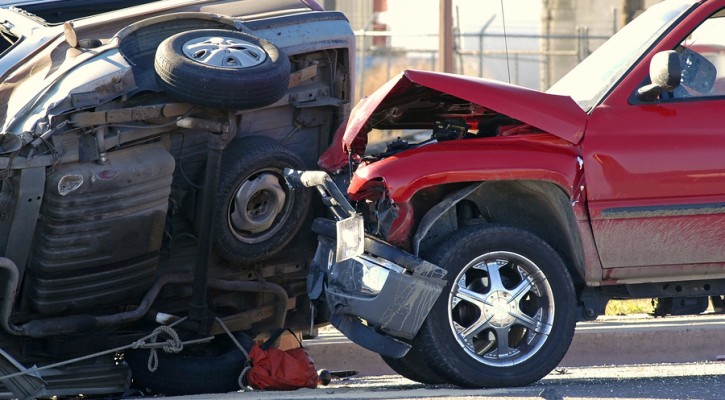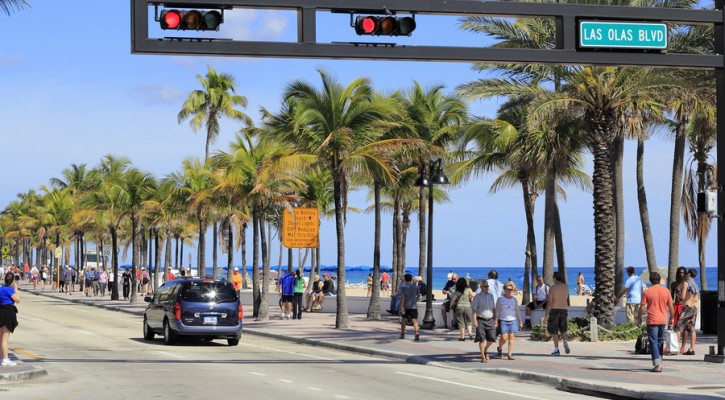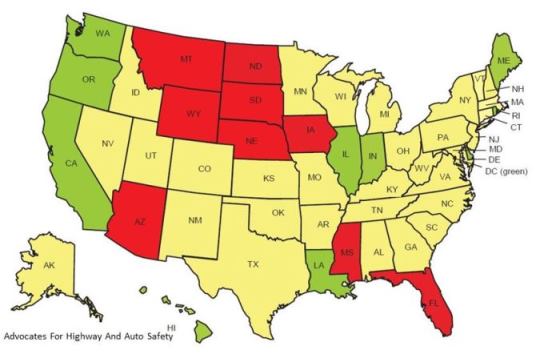Category Archive: Safety

Samsung Tests Safety Technology To Improve the View Ahead
June 22, 2015
Samsung is testing a fairly simple product idea that could make driving safer and save a lot of lives.
If you’ve ever been stuck behind a large semi on a narrow road, you know the frustration that comes from not being able to see the road ahead in order to pass the truck safely. Even when the truck may be going relatively slowly, its size makes passing hazardous because of the extra time required to pass and the danger of unseen oncoming traffic. This frustration can lead drivers to make dangerous choices that can result in a crash.
By using a front mounted camera and four large display screens on the rear of the truck, Samsung is testing a video display that will show the road ahead to drivers behind the truck. The video display of the road ahead works even on the darkest roads. Hopefully, the video display will allow drivers to make more informed and safer choices when deciding whether or not it’s safe to pass.
Noting that it has one of the highest highway death rates in the world and that many of the roads there are two lane roads, Samsung started testing this new idea in the country of Argentina.
According to the Samsung blog, the results look promising but more testing needs to be done.
Part of the data that needs to be evaluated is whether or not drivers will adapt to using this technology for its intended purpose or will it become just another driver distraction that takes the driver’s attention away from the road as a whole. Before testing can be done in other countries, testing protocols have to be developed and government permission has to be obtained.
Unfortunately, while the technology could prove to be extremely helpful to drivers behind a truck, it won’t do anything to eliminate the large no-zones around a truck that prevent the truck driver from seeing vehicles behind and alongside. Drivers will still need to be aware of and respect the no-zones while attempting to pass.
Read more: The Safety Truck Could Revolutionize Road Safety
Photo: Courtesy of Samsung

Collision Avoidance Systems Should Be Standard Equipment On All Vehicles: NTSB
June 12, 2015
Collision avoidance systems should be standard equipment on all new vehicles according to a new report issued by the National Transportation Safety Board (NTSB). The NTSB is the federal agency whose job is to investigate transportation crashes of all types; aircraft, train, ship, bus, or truck. The report came about as a result of the investigation of just nine rear end motor vehicle crashes involving 48 vehicles that resulted in 28 deaths and 90 injuries.
In the US, rear end crashes are the most common type of crash involving two or more vehicles. According to the NTSB report, rear end crashes make up almost half of all motor vehicle crashes involving two or more vehicles. In the years 2011 and 2012, rear end crashes resulted in the deaths of 3,491 people and more than a million injuries. In 2012 alone, there were more than 1.7 million rear end crashes.
There are several reasons for rear end collisions including; driver distraction, false expectations of of driver intent, unsafe speed, and fatigue. However, the most common reason, according to the National Highway Transportation Safety Administration (NHTSA) is driver distraction. According to NHTSA, 87 percent of rear end crashes are due to driver distraction.
Several different types of collision prevention systems have been available over the past 20 years including;
- Collision warning systems (CWS) that alerted a driver to the possibility of a collision.
- Adaptive cruise control (ACC) that automatically maintains a safe following distance between vehicles ahead.
Both the CWS and ACC systems are passive systems that still required the driver to take action to avoid a rear end crash but the driver may not react in time.
The latest version, known as the collision avoidance system (CAS) combines the CWS and ACC into an active system that takes control of the vehicle to avoid a crash. If the CAS system senses a probable crash, it will automatically apply the brakes in time to avoid the crash. The CAS system can respond much faster than the human driver.
Using the data from the 2011 and 2012 crash database, the NTSB estimated that the use of a collision avoidance system could have saved up to 2,220 lives. They also estimated that injuries could have been avoided or reduced in 93.7 percent of those crashes.
Collision avoidance systems are already available in a few high end model cars. The NTSB is making the following recommendations regarding collision avoidance systems:
- For manufacturers to install forward collision avoidance systems as standard features on all newly manufactured passenger and commercial motor vehicles,
- For NHTSA to expand the New Car Assessment Program to include a graded rating to assess the performance of forward collision avoidance systems, and
- For NHTSA to expand or develop protocols for the assessment of forward collision avoidance systems in passenger and commercial vehicles.
Read more: Safety Shouldn’t Be a Luxury Feature

Bicycle Deaths – Florida Sets Another Record
May 18, 2015
When it comes to roadway safety, Florida has set another record – the highest rate of bicycle deaths in the nation. Florida’s lead in bicycle deaths follows another Florida record as the number one killer of pedestrians.
In terms of population, Florida is only the third largest state in the US after California and Texas so it would seem that those two states would have a much higher rate of bicycle deaths and in raw numbers, that may be true but when you compare populations, Florida has the highest rate of all.
Let’s look at how the numbers fall out.
|
State |
Population in millions |
Number of registered motor vehicles in millions |
Number of cyclists killed |
Rate of cyclists killed per million of population |
|
California |
38.8 |
33.55 |
141 |
3.68 |
|
Texas |
26.96 |
23.87 |
48 |
1.81 |
|
Florida |
19.89 |
19.64 |
133 |
6.8 |
Florida, with less than half of the population and just a little over half the number of registered vehicles of California, had just eight fewer bicycle deaths than California. When compared to the rate of bicycle deaths per million population, Florida beats every other state in the nation.
So, what’s Florida doing wrong? The League of American Bicyclists puts out a report card every year that rates states on their friendliness to cyclists. To rate states they look at;
- Legislation and enforcement;
- Policies and programs;
- Infrastructure and funding;
- Education and encouragement; and
- Evaluation and planning
In their latest ranking, the League rates California as the eighth friendliest state for cyclists while it rates Florida 24th. In all five categories, California ranks near the top while Florida’s rankings are near the bottom.
The two main areas that Florida needs to work on are:
- Vulnerable road user law – A law was proposed in the last session of the legislature that would have imposed higher penalties for any driver that passes or turns in front of a vulnerable road user (pedestrians, cyclists, animal riders, personal mobility devices) in an unsafe manner. The bill looked like a sure thing to pass however, in a dispute between the Florida Senate and the House, the bill failed to pass during this session.
- Complete Streets – Complete Streets are roadway projects designed with both cyclists and pedestrians in mind. When widening existing roads or proposing new roadways, Florida is falling short in planning and designing for Complete Streets.
Read More: The Deadliest States for Bikers

Drivers Prefer Collision Avoidance Over Wireless Technologies
April 29, 2015
A study published last week By J.D. Power shows that consumers prefer collision avoidance technology over wireless connectivity in their automobiles. At a time when auto manufacturers seem to be rushing to add more and more distracting wireless technologies to their new vehicles, this study comes as a welcome bit of news to driving safety advocates.
The J.D. Power 2015 U.S. Tech Choice Study showed that the top three out of five technologies consumers wanted in their next vehicle are collision avoidance technologies. The top three choices are:
- Blind spot detection and prevention systems,
- Night vision, and
- Enhanced collision mitigation systems.
According to J.D. Power, consumers are showing more acceptance of self-driving vehicles and the top three technologies that consumers prefer are the building blocks for eventual fully autonomous vehicles.
The study showed that the last two preferences on the top five are camera rearview mirrors, a driver assistance aid, and self-healing paint which falls into the “comfort and convenience category.”
Choices between operating systems and wireless carriers are one of the reasons consumers felt less inclined to prefer wireless technologies in new vehicles. Consumers are loyal to either Android or Apple operating systems and their wireless carrier. Consumers are wary about having the automaker choose an operating system for them and, until automakers solve the problem of a one size fits all system, wireless will remain a low priority.
Consumers also showed little enthusiasm for “advanced sensor technologies, such as hand gesture controlled seats, biometric driver sensors, or haptic touch screens.”
Read more: Consumer Preference for Collision Protection Technologies Paves the Way for Autonomous Driving

Florida Leads In Pedestrian Deaths
March 4, 2015
Florida continues to be among the deadliest states for pedestrians according to a report from the Governor’s Highway Safety Association (GHSA). The recently released report found that, nationwide, pedestrian deaths were just about the same in 2014 as they were in 2013. However, Florida’s pedestrian deaths continue to rise.
When comparing the preliminary pedestrian death rate for the first six months of 2013 and 2014, Florida led the nation with 292 pedestrian deaths; an increase of 50 deaths over the same six month period in 2013.
Florida is the third most populous state in the nation yet, when looking at the total pedestrian deaths for 2013, Florida, with 501 pedestrian deaths ranked second only behind California’s total of 701. Florida, with only 51 percent of California’s population had a pedestrian death rate equal to more than 71 percent of California’s. When looking at the pedestrian death rate per 100,000 population, Florida takes the lead.
|
State |
Population in millions |
Pedestrian death total |
Per 100,000 population |
|
California |
38.8 |
701 |
1.83 |
|
Texas |
26.9 |
480 |
1.81 |
|
Florida |
19.9 |
501 |
2.56 |
|
New York |
19.7 |
335 |
1.70 |
One might make the claim that the large number of tourists that visit Florida each year might skew the results. That idea might hold up if Florida led the nation in tourism but it doesn’t. California leads the nation in tourism followed by Florida according to a study by HotelsCombined, a hotel booking site.
Clearly Florida and Florida’s drivers are doing something wrong. A 2014 study by the George Washington University School of Business listed Orlando as the most dangerous city in the US for pedestrians and ranked Tampa and Miami among the top ten least walkable cities in America.
Florida cities need to consider walkability as part of their plan when building or improving roadways. Florida drivers need to be more aware of pedestrians, especially in heavily traveled tourist areas. Part of being a good defensive driver is considering what you would do if a pedestrian were to walk out into the roadway.
To read more, visit: http://www.ghsa.org/html/files/pubs/spotlights/spotlight_ped2014.pdf

Florida Fails When It Comes To Safe Driving Laws
January 22, 2015
When it comes to safe driving laws, Florida ranks near the bottom compared with other states according to a report published today by Advocates for Highway and Auto Safety (Advocates). The report ranks states based on fifteen basic driving safety laws, giving points for each law a state has on its books.
The report used a three color grading system based on each state’s overall score. Grades given were:
- Green – State is significantly advanced toward adoption of all Advocates’ recommended highway safety laws.
- Yellow – State is advancing but has numerous gaps in its highway safety laws.
- Red – State falls dangerously behind in adoption of key safety laws.
Florida was one of nine states to receive a red score with only six out of the fifteen recommended safe driving laws enacted.
This year’s report stresses what the Advocates call “lethal loopholes” in laws that fail to protect drivers and passengers and contribute to preventable deaths and injuries. Lethal loopholes refer to laws that don’t go far enough to protect vehicle occupants or that are “secondary enforcement laws.” For those unfamiliar with secondary enforcement laws, we need to take a moment to explain how they work.
A good example of a secondary enforcement law in Florida is the new anti-texting law that took effect in October of 2013. The law, which prohibits drivers from writing, sending, or reading written communications on any wireless communications device, sounds like a good law at first glance however, the law is a secondary enforcement law. That means that a law enforcement officer can’t stop a driver and issue a ticket just for texting alone. The officer must first witness a driver texting while, at the same time, violating a primary enforcement law such as speeding or running a red light before stopping the driver and issuing a ticket. As a result, Florida’s anti-texting law is basically toothless and law enforcement agencies throughout the state report that they have issued very few tickets under this law.
When ranking states on whether or not they had one of the fifteen laws on the books, the Advocates didn’t count those laws that were secondary enforcement laws. They also didn’t give points to laws that didn’t go far enough to protect vehicle occupants from injury or death. In Florida’s case, those laws include:
- Florida’s newly enacted child booster seat law that only requires the use of booster seats for children under the age of five. Adult seat belts don’t fit children properly and the Insurance Institute for Highway Safety (IIHS) recommends that children remain in a booster seat until they are at least 4’9” tall. For the average child, that can be anywhere from 9 to 11 years of age. Effective booster seat laws require the use of a booster seat until the child is either 4’9” tall or 9 years of age.
- Florida’s seat belt law is a primary law for occupants of the front seat and anyone under the age of 18 no matter where they are seated. However, it doesn’t require the use of seat belts by back seat occupants over the age of 18.
- Graduated Driver License (GDL) laws are designed to give teen drivers more driving experience without distractions until they have more experience. Effective GDL laws restrict the number of passengers a teen can carry, limit night time driving, and the use of cell phones. Florida’s GDL laws have no restrictions on passengers or the use of cell phones by newly licensed teen drivers. In 2012, Florida came in at third place after Texas and California in the number of highway deaths involving teen drivers.
- Florida’s motorcycle helmet law allows riders over the age of 21 with at least $10,000 worth of medical insurance coverage to ride without a helmet. Florida, with only 47% of the riders using helmets, led the nation in motorcycle deaths in 2012.
For more information on how Florida’s safe driving laws scored, read: 12TH ANNUAL ROADMAP OF STATE HIGHWAY SAFETY LAWS
Image compliments of: Advocates for Highway and Auto Safety

Legislators Seek To Raise Speed Limits
January 16, 2015
It’s that time of year again when state legislatures meet and bills to raise speed limits on interstates and state roads are introduced. Bills are being introduced in several states to raise the speed limit on interstates within the state’s borders up to 75 and even 80 mph. Apparently, the legislators who are pushing for these bills are pandering to constituents who want the speed limits raised without considering the danger posed by those speed limit increases.
In 2011, the State of Kansas increased speed limits to 75 mph on certain highways. According to Kansas Department of Transportation statistics, in the two years following the speed limit increase, the number of deaths on those Kansas highways where the speed limit was raised increased by 54 percent. Injury collisions also increased on those highways by 13 percent compared to the two years before the law change.
The Kansas statistics follow other studies that have found increases in the death rate after speed limits were raised. A 2009 study published in the American Journal of Public Health looked at the death rate on American highways after congress abolished the federal maximum speed limit in 1995. The study found an increase in the death rate of 3.2 percent on all roads, a 9.1 percent increase on rural interstates and a 4 percent increase on urban interstates. What that meant in real numbers were 12,545 deaths and 36,583 injuries that were directly attributed to the increase in speed limits.
In 2006, Iowa’s Department of Transportation conducted a study looking at the death rate in several mid-western states that had raised speed limits compared to states that didn’t. They found an overall fatality increase of nine percent in those states that raised the speed limit compared with a seven percent reduction in the states that hadn’t raised the speed limit.
Higher speed is a problem because it reduces a driver’s time to react to an emergency on the road. Higher speeds also make it more difficult to keep a car on the road on curves or when trying to avoid a crash. Higher speeds also increase the crash forces exponentially. When comparing a crash with a car hitting a stationary object at 70 mph vs the same crash at 75 mph, the difference between 70 and 75 mph represents an increase in speed of only seven percent but an increase of 14 percent in crash forces. According to figures from the National Highway Traffic Safety Administration (NHTSA), speed was responsible for approximately one-third of all highway deaths in 2012.
Some legislators maintain that increased speed limits allow goods to travel to markets faster, saving money and creating a business friendly environment. According to a May 2014 report by NHTSA, crashes involving a speeding vehicle traveling over the posted limit or too fast for conditions cost the nation $59 billion in 2010, an average of $191 for every person in the U.S.
In last year’s legislative session, the Florida legislature passed a bill that would have increased the speed limit on certain Florida highways to 75 mph but after protests from the Florida highway patrol, other law enforcement agencies, and safety experts, the governor vetoed the bill.

Crashes Increase After Red Light Cameras Are Removed
November 24, 2014
A recent report by WBBH TV in Florida shows that crashes increased at intersections after red light cameras were removed. The Collier County, FL board of commissioners voted in 2013 to remove red light cameras saying there was no proof they made the streets safer. In their report, WBBC compared crash data during the 18 months after the cameras were removed to crash data for the 47 months the cameras were in use. The results showed that, on average, there were ten more crashes per month after the cameras were removed than when they were there. Continue Reading

Extending Graduated Driving Laws Beyond Age 17
November 3, 2014
Should state legislatures consider extending graduated driving laws beyond age 17? According to a recent study by the AAA Foundation for Traffic Safety, in spite of the fact that many teens are delaying getting a license until they are older, novice drivers could benefit from graduated driving laws (GDL), even if they are older than age 18.
By looking at teen crash statistics in two states where GDL laws apply only to 16 and 17 year olds and comparing them to the State of New Jersey, where GDL laws apply to all drivers up to the age of 21, AAA feels the data shows that state legislatures should consider extending graduated driving laws, at least for the first six months, for all novice drivers under the age of 21.

A single statistic can increase public support for traffic safety laws
October 8, 2014
Awareness of a single statistic can change public attitudes regarding the need for certain traffic laws according to a study conducted by the Johns Hopkins Center for Injury Research and Policy at the Johns Hopkins Bloomberg School of Public Health.
The researchers surveyed 2,397 adults across the nation concerning their opinion (for or against) of four separate traffic safety laws – mandatory use of bicycle helmets for children under 16, the use of red-light cameras in school zones, mandatory ignition interlock installation for people convicted of driving under the influence (DUI) and a requirement that in-vehicle information entertainment systems be disabled when a car is moving.
After tabulating the results, the respondents were given a statistic showing the injury risk associated with the law or the ability of the law to reduce those injuries. They were then given another survey on their attitudes toward the laws. After viewing the statistics, the number of respondents showing support for the laws increased dramatically.
In the first survey a majority of respondents reported that they were supportive or strongly supportive of the laws:
- 74.8 percent favored mandatory use of bicycle helmets for children under 16
- 74.4 percent favored mandatory ignition interlock installation for people convicted of driving under the influence (DUI)
- 61.4 requirement that in-vehicle information entertainment systems be disabled when a car is moving.
- 58 percent favored use of red-light cameras in school zones
After receiving statistic showing the law’s effectiveness in preventing injuries, respondents showing support for the laws increased by:
- 30.7 percent for requirement that in-vehicle information entertainment systems be disabled when a car is moving.
- 22.2 percent for use of red-light cameras in school zones
- 20 percent for mandatory use of bicycle helmets for children under 16
- 20 percent for mandatory ignition interlock installation for people convicted of driving under the influence (DUI)
State legislators are often wary of enacting new traffic safety laws because they feel that the public won’t support the measure. However, in many cases, either the legislators have failed to properly gauge public support or those in favor of the law have failed to make their voices heard.
